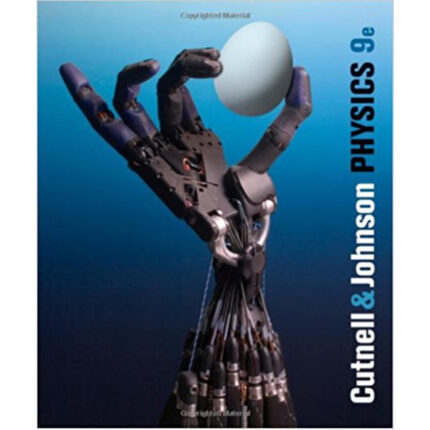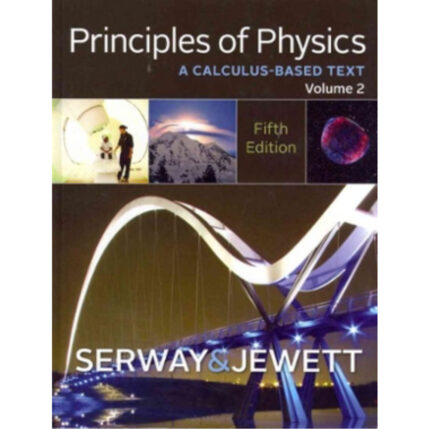Physics Foundations And Connections With Modern Physics for Scientists And Engineers (1st Edition) – Debora M. Katz
1. A 3.0-kg ball with an initial velocity of m/s collides with a wall and rebounds with a velocity of m/s. What is the impulse exerted on the ball by the wall?
a. +24 N s
b. −24 N s
c. +18 N s
d. −18 N s
e. +8.0 N s
ANSWER: b
POINTS: 2
DIFFICULTY: Average
2. A 2.4-kg ball falling vertically hits the floor with a speed of 2.5 m/s and rebounds with a speed of 1.5 m/s. What is the magnitude of the impulse exerted on the ball by the floor?
a. 9.6 N s
b. 2.4 N s
c. 6.4 N s
d. 1.6 N s
e. 1.0 N s
ANSWER: a
POINTS: 2
DIFFICULTY: Average
3. An 8.0-kg object moving 4.0 m/s in the positive x direction has a one-dimensional collision with a 2.0-kg object moving 3.0 m/s in the opposite direction. The final velocity of the 8.0-kg object is 2.0 m/s in the positive x direction. What is the total kinetic energy of the two-mass system after the collision?
a. 32 J
b. 52 J
c. 41 J
d. 25 J
e. 29 J
ANSWER: c
POINTS: 3
DIFFICULTY: Challenging
4. A 1.6-kg ball is attached to the end of a 0.40-m string to form a pendulum. This pendulum is released from rest with the string horizontal. At the lowest point of its swing, when it is moving horizontally, the ball collides with a 0.80-kg block initially at rest on a horizontal frictionless surface. The speed of the block just after the collision is 3.0 m/s. What is the speed of the ball just after the collision?
a. 1.7 m/s
b. 1.1 m/s
c. 1.5 m/s
d. 1.3 m/s
e. 2.1 m/s
ANSWER: d
POINTS: 3
DIFFICULTY: Challenging
5. A 2.0-kg object moving with a velocity of 5.0 m/s in the positive x direction strikes and sticks to a 3.0-kg object moving with a speed of 2.0 m/s in the same direction. How much kinetic energy is lost in this collision?
a. 2.4 J
b. 9.6 J
c. 5.4 J
d. 0.6 J
e. 6.0 J
ANSWER: c
POINTS: 3
DIFFICULTY: Challenging
6. A 6.0-kg object moving 5.0 m/s collides with and sticks to a 2.0-kg object. After the collision the composite object is moving 2.0 m/s in a direction opposite to the initial direction of motion of the 6.0-kg object. Determine the speed of the 2.0-kg object before the collision.
a. 15 m/s
b. 7.0 m/s
c. 8.0 m/s
d. 23 m/s
e. 11 m/s
ANSWER: d
POINTS: 2
DIFFICULTY: Average
7. A 2.0-kg object moving 5.0 m/s collides with and sticks to an 8.0-kg object initially at rest. Determine the kinetic energy lost by the system as a result of this collision.
a. 20 J
b. 15 J
c. 30 J
d. 25 J
e. 5.0 J
ANSWER: a
POINTS: 2
DIFFICULTY: Average
8. A 3.0-kg mass sliding on a frictionless surface has a velocity of 5.0 m/s east when it undergoes a one-dimensional inelastic collision with a 2.0-kg mass that has an initial velocity of 2.0 m/s west. After the collision the 3.0-kg mass has a velocity of 1.0 m/s east. How much kinetic energy does the two-mass system lose during the collision?
a. 22 J
b. 24 J
c. 26 J
d. 20 J
e. 28 J
ANSWER: b
POINTS: 3
DIFFICULTY: Challenging
9. A 3.0-kg mass is released from rest at point A of a circular frictionless track of radius 0.40 m as shown in the figure. The mass slides down the track and collides with a 1.4-kg mass that is initially at rest on a horizontal frictionless surface. If the masses stick together, what is their speed after the collision?
a. 2.1 m/s
b. 1.7 m/s
c. 1.9 m/s
d. 1.5 m/s
e. 2.3 m/s
ANSWER: c
POINTS: 2
DIFFICULTY: Average
10. A 10-g bullet moving horizontally with a speed of 2.0 km/s strikes and passes through a 4.0-kg block moving with a speed of 4.2 m/s in the opposite direction on a horizontal frictionless surface. If the block is brought to rest by the collision, what is the kinetic energy of the bullet as it emerges from the block?
a. 0.51 kJ
b. 0.29 kJ
c. 0.80 kJ
d. 0.13 kJ
e. 20 kJ
ANSWER: a
POINTS: 3
DIFFICULTY: Challenging













Reviews
There are no reviews yet.